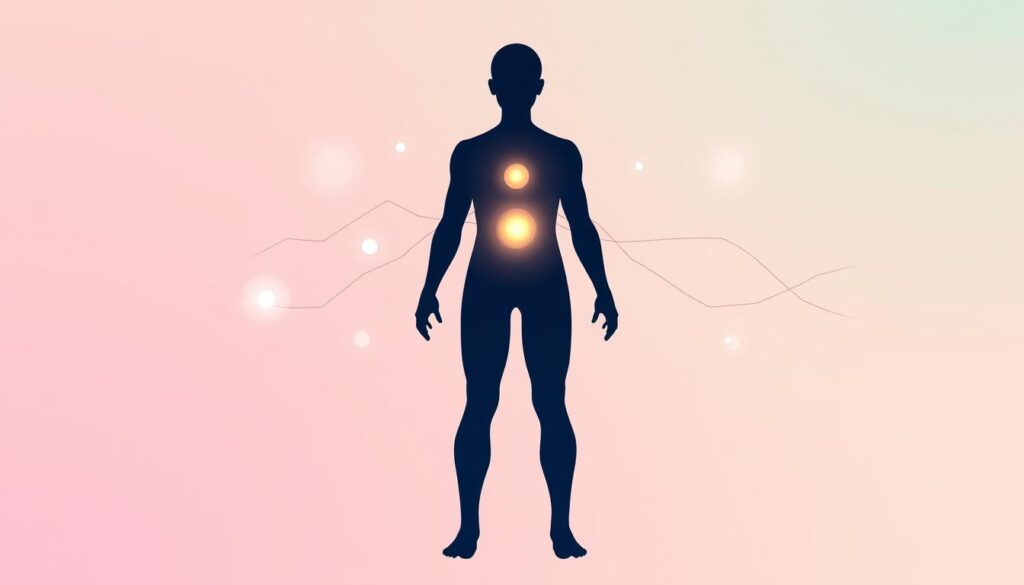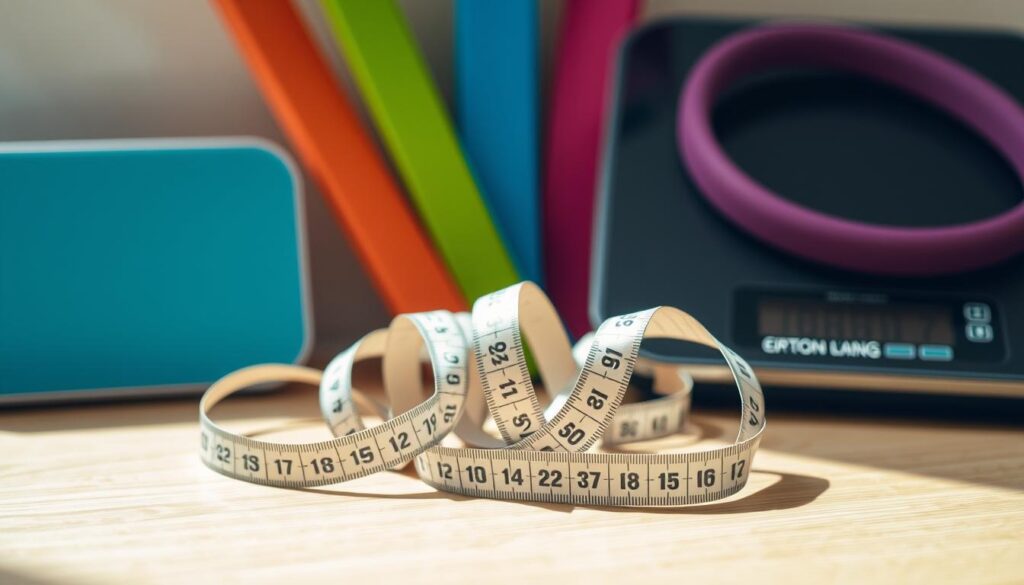Body recomposition means losing fat and gaining muscle at the same time. It uses calorie cycling, eating lots of protein, and doing resistance training. This method is different from just trying to lose weight. It aims to make your body leaner and more muscular.
To succeed in body recomposition, you need to know the right mix of carbs, proteins, and fats. This mix helps you lose fat and build muscle. This guide will explain the science behind it. It will also give you the macros and strategies you need to change your body.
Key Takeaways
- Body recomposition involves simultaneously losing fat and gaining muscle, unlike traditional weight loss.
- Optimal macronutrient distribution for body recomposition is 30-35% carbohydrates, 30-35% proteins, and 30-40% fats.
- Precise calorie and macro tracking can help you achieve your body recomposition goals.
- Patience and consistency are key, as results may take several months to achieve.
- Incorporating resistance training and strategic carbohydrate cycling are essential for success.
Understanding Body Recomposition Fundamentals
Body recomposition is a special way to get in shape. It’s about losing fat and gaining lean muscle at the same time. This method is different from just trying to lose weight. It involves changing what you eat and how you exercise to get the best results.
The Science Behind Simultaneous Fat Loss and Muscle Gain
To succeed in body recomposition, you need to find the right balance. Eating the right number of calories and lots of good protein helps. This way, you can lose fat and grow muscle at the same time.
Research shows eating 1.4 grams of protein for every kilogram of your weight helps keep muscle when you’re eating fewer calories.
Differences Between Body Recomposition and Traditional Weight Loss
Body recomposition focuses on improving how your body looks, not just losing weight. Unlike losing weight, which can mean losing muscle too, this method tries to keep or grow muscle while losing fat.
Key Principles of Successful Body Transformation
- Strategic calorie cycling: Alternating between periods of calorie surplus and deficit to optimize muscle growth and fat loss.
- High-protein intake: Consuming 2.6 to 3.5 grams of protein per kilogram of body weight daily to support muscle building.
- Progressive overload in strength training: Gradually increasing the intensity, volume, and weight of your workouts to stimulate muscle growth.
By following these key principles, you can start a journey to change your body. This journey will not only make you look better but also improve your health and fitness.
How Body Recomposition Actually Works
Body recomposition means losing fat and gaining muscle at the same time. It happens with the right food and workouts. You need to balance calories, eat enough protein, and do resistance training.
To lose fat and gain muscle, you need to eat more on some days and less on others. This keeps your metabolism up and helps your muscles grow. It’s all about the right balance.
Working out with weights is key to building muscle. It makes your muscles bigger and stronger. Eating a lot of protein helps your body fix and grow muscles.
Eating the right amount of protein is very important. Studies say eating 30-35% of your calories as protein helps you lose fat and gain muscle. It’s all about the right mix.
“The secret to body recomposition is not a secret at all – it’s a delicate balance of strategic nutrition and targeted resistance training.”
Understanding body recomposition can change your body. You can lose fat and gain muscle. Just remember to stay consistent and adjust as needed. Your body can do amazing things with the right food and workouts.
Fat Loss Muscle Gain Macros: Essential Guidelines
To lose fat and gain muscle, you need a good plan for your food. Here are the key steps to help you succeed:
Protein Requirements for Muscle Growth
Protein helps build and fix muscles. Eat 0.7 to 1 gram of protein per pound of body weight for losing fat. For gaining muscle, eat 0.54 to 1 gram per pound. If you want to lose fat but keep muscle, eat more protein.
Strategic Carbohydrate Intake
Carbs are important for muscle repair and growth. For losing fat, eat carbs after protein and fat. Aim for 30 to 50 percent of your daily calories from carbs. When you’re bulking, eat 3 to 5 grams of carbs per kilogram of body weight.
Optimal Fat Distribution
Fats are key for hormones and health. Eat at least 0.3 grams of fat per pound of body weight when losing fat. Make sure 20 to 35 percent of your daily calories are from healthy fats.
These are general tips. Your needs might be different based on your activity, body, and health. Try different amounts to find what works best for you.
Calculating Your Daily Caloric Needs
Finding out how many calories you need every day is key to losing fat and gaining muscle. Knowing your basal metabolic rate (BMR) and total daily energy expenditure (TDEE) helps. This way, you can eat the right amount of calories to reach your goals.
Your BMR is the least number of calories your body needs when you’re not moving. Your TDEE includes calories burned from daily activities and workouts. Use online tools to figure out your TDEE based on your age, gender, weight, and how active you are.
To lose fat, aim for a calorie deficit of 15-20% from your TDEE. This deficit, along with good training and eating, helps you lose fat and keep or gain muscle.
Keep an eye on how you’re doing as you work on your body. Adjust your calorie intake when you need to. Eating more on workout days and less on rest days can help with muscle growth and fat loss.
Everyone’s calorie needs are different. Be patient, watch your progress, and seek help from a nutrition expert if you need it.
| Gender | Average Daily Caloric Needs |
|---|---|
| Men | 2,000 – 3,000 calories |
| Women | 1,600 – 2,400 calories |
Your calorie needs can change based on your age, how active you are, and more. Use the Mifflin-St Jeor Equation or Katch-McArdle Formula to guess your BMR. Then, add your activity level to find your TDEE.

Creating Your Body Recomposition Meal Plan
To lose fat and gain muscle at the same time, you need a good diet plan. Choose nutrient-dense foods that help you reach your fitness goals.
Meal Timing and Frequency
The number of meals you eat each day is up to you. Some people do well with 3 to 6 meals. This helps keep your hunger in check and keeps your body fueled.
Make sure to eat protein before and after working out. This helps your muscles grow and recover.
Food Choices for Optimal Results
Eat a mix of lean proteins, complex carbohydrates, and healthy fats. Aim for a diet with 30-35% carbs, 30-35% protein, and 30-40% fats. This mix gives your body what it needs to work well and help you reach your goals.
Pre and Post Workout Nutrition
Plan your meals around your workouts for best results. Eat a meal with carbohydrates and protein before working out. This gives you energy and helps build muscle.
After working out, eat a meal with lots of protein and carbohydrates. This helps your muscles recover and fills up your energy stores.
“The key to successful body recomposition is to focus on whole, nutrient-dense foods that support your fitness goals.”
Training Strategies for Body Recomposition
To reach your body recomposition goals, you need a smart training plan. Start with resistance training to grow muscles and boost your metabolism. Choose big exercises like squats, deadlifts, and bench presses. They work many muscles at once and help you get stronger.
Use progressive overload to get stronger. Slowly add more weight, reps, or sets to your workouts. This makes your muscles work harder and grow, helping you reach your goals.
- Strength training should be the primary focus, with a emphasis on compound exercises.
- Gradually increase the intensity and volume of your resistance training workouts over time.
- Complement your strength training with high-intensity interval training (HIIT) to enhance fat loss.
Balance how hard you train and how much rest you get. This helps you recover and avoid getting too tired. Mix strength training, cardio, and flexibility to get the best results.
“Resistance training is the cornerstone of any effective body recomposition program. By challenging your muscles and progressively overloading them, you’ll stimulate growth and boost your metabolic rate, setting the stage for fat loss and muscle gain.”
Remember, being consistent and patient is crucial. Stick to your plan and watch your progress. With the right approach, you can lose fat and gain muscle at the same time.
The Role of Rest and Recovery
Getting the body you want isn’t just about eating right and working out. You also need enough rest and recovery. Good sleep and stress control are key to your success.
Sleep Quality and Hormonal Balance
Try to sleep 7-9 hours each night. This helps your muscles grow and fat to melt away. Sleep quality keeps hormones like cortisol in check, which is good for you.
Keep your sleep schedule regular. Also, have a calm bedtime routine. This improves your sleep hygiene.
Managing Stress for Better Results
Too much stress can mess up your body’s recovery. It makes cortisol levels go up. Use stress-busting activities like meditation or hobbies to help your body heal.
Adding light exercises, stretching, and foam rolling to your routine helps too. It lets your muscles recover and keeps you from getting too tired. Rest well between workouts to help your muscles grow.
“Sleep and stress management are often overlooked, but they play a critical role in successful body recomposition. Prioritize your rest and recovery for optimal results.”
Focus on sleep, stress control, and recovery to help your body change. This way, you can get the body you’ve always wanted.
Tracking Progress and Making Adjustments
The journey to change your body is long. It’s important to track your [body measurements], [progress photos], and [performance metrics] often. This helps you see how your body reacts to diet and exercise.
Watch how your [weight], [body fat percentage], and [muscle mass] change. Also, notice if you get stronger and do better in workouts. These signs can show if you need to change your [diet] or workout plan.
- Regularly measure your [body measurements] such as waist, hips, and chest circumference to track progress.
- Take [progress photos] every 4-6 weeks to visually document changes in your physique.
- Monitor your [performance metrics] like lift weights, reps, and cardiovascular endurance.
- Adjust your [diet] and training based on your progress and plateaus.
Being patient and consistent is crucial. Trust the process and make small changes. Stay focused on your long-term goals. With a good plan and tracking, you can get the body you want.

“Consistency is the key to success in any fitness journey. Trust the process and keep tracking your progress.”
Common Mistakes to Avoid During Body Recomposition
Starting a body recomposition journey is tough. It’s key to avoid common mistakes that can stop your progress. One big mistake is overtraining. It can make you tired and hurt your body’s ability to heal and grow muscle.
Another mistake is undereating. Eating too few calories can slow down your metabolism. This makes it hard to lose fat and gain lean muscle. It’s important to find the right balance of calories and activity to reach your goals.
Being consistent is crucial for body recomposition. Inconsistency can block your progress. Try to keep a steady diet and workout plan that you can keep up with for a long time.
Lastly, setting realistic expectations is vital. Don’t expect too much too soon. Focus on the long-term and celebrate small victories. This way, you’ll stay motivated and see progress.


A Life-Changing Experience with This Weight Loss Supplement (Nagano Tonic)
I’ve always struggled with finding a weight loss solution that actually works for me. Like many, I’ve tried numerous diets, exercise routines, and supplements over the years—some worked for a short time, but nothing ever gave me long-term results. That was until I decided to try the weight loss supplement I found : Link to the Supplement.
From the moment I started using it, I noticed a difference. Not only did I feel more energized, but my cravings also became more manageable. The best part? I started seeing results much quicker than I anticipated! Over the course of just a few weeks, I noticed a significant reduction in belly fat and overall weight loss that I hadn’t been able to achieve before.
What makes this supplement stand out from all the others I’ve tried is how it supports me in my daily routine without any jitters or energy crashes. I’m able to stay focused and motivated, which has made it easier to stay on track with my diet and exercise plan.
This product truly exceeded my expectations, and I feel more confident and healthier than ever before. If you’re struggling with your weight loss journey like I was, I highly recommend giving this supplement a try. It’s been a game-changer for me, and I’m sure it can work wonders for you too!
Contant Them on email .. tonicnagano50@gmail.com
I’ve tried so many weight loss products over the years, but nothing worked like this supplement! Since I started using it, I’ve noticed a big difference in my energy levels and appetite control. In just a few weeks, I’ve lost weight and feel so much better. It’s been easy to stick with, and the results speak for themselves. Highly recommend this to anyone looking to make a real change!
I was skeptical at first, but this supplement has truly made a difference in my weight loss journey. I’ve lost weight without feeling deprived or sluggish. My cravings are under control, and I feel more confident in my body. It’s easy to incorporate into my daily routine, and the results speak for themselves. I’m so glad I gave it a try!
Thanks David, i do use the link to make my purchase. you can get too here http://surl.li/iasppy
I’ve tried so many weight loss products, but this one has been by far the most effective. In just a few weeks, I’ve noticed a visible difference in my body and energy levels. It’s helped me stay on track without the constant hunger pangs and cravings. I’m really happy with my progress and can’t wait to see where I’ll be in another month!
This Nagano Tonic has been amazing! In just a few weeks, I’ve lost weight, feel more energized, and my cravings are under control. Highly recommend it!
Thats the link to purchase http://surl.li/iasppy